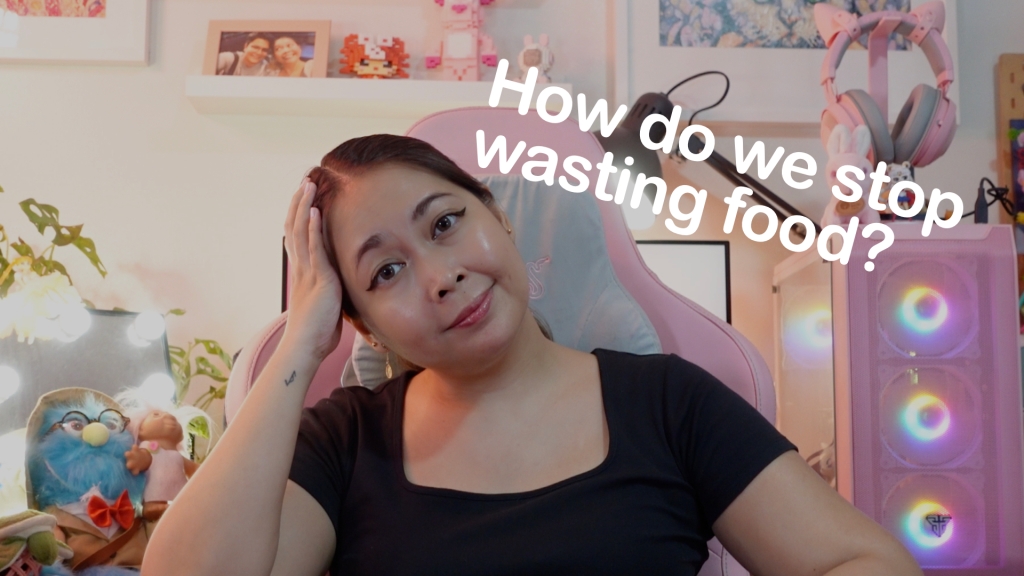Hello Science Fans!
Did you know that in Metro Manila we throw away 2,175 tons of food waste everyday. Shocking right?
Food waste is a big problem because it’s like pouring valuable resources down the drain, contributing to hunger, harming the environment, wasting our money, and encouraging too much production and consumption.
It sounds simple enough but there is a lot more to it than just eating the food on your plate and making sure nothing goes to waste.
What’s the big deal about food waste anyway?
Learn about the answer to this question by reading this article or by checking out our video below:
Before I answer this questions using science, let me first greet our new viewers.
Hi, I’m Chona and I’m your resident Filipina scientist.
I’m a researcher who develops practical technologies to help our fishers and farmers produce more food with less waste.
I’m a teacher who loves showing my students more sustainable ways of going about our daily lives to lessen our negative impact on the environment.
And SHE-ensya is my science communication channel where I try to show people how ruining the environment is equal to ruining our lives.
Now, let’s dive deeper as to why food waste is such a big problem.
When we throw away food, we are also wasting the resources used to produce it, like water, energy, and land. This is like filling up a bathtub and then letting all the water flow down the drain without using it. Please remember also that many people around the world don’t have enough to eat. When we waste food, it’s like having extra food on our plate and not sharing it with someone who’s hungry. Throwing away food also means throwing away our money. We spend our hard-earned money on groceries and then throw a lot of it in the trash, which is like throwing away our money.
Rotting food in landfills produces harmful greenhouse gases, like methane, which contribute to climate change. So, wasting food harms the environment and makes global warming worse. But it’s not just about converting this food waste into compost and fertilizers. When we waste food, it encourages producers to make more than we really need, which can put more pressure on our environment and resources.
So if we want to reduce food waste, we have to know where they’re coming from. Because it’s not just your plate.
Food waste can occur during the agricultural production and harvesting stages due to factors such as crop diseases, pests, weather conditions, and inefficient farming practices. Sometimes, fruits and vegetables are left unharvested or discarded because they do not meet aesthetic or size standards set by retailers. And then, food processing and manufacturing industries may generate waste when processing raw ingredients into food products. This can include trimming, peeling, and discarding parts of fruits, vegetables, and meat that are not used in the final product. Food can also be wasted during distribution and at retail stores. This can happen due to spoilage, damage during transportation, and overstocking of products that exceed their sell-by or use-by dates. Retailers may also discard products that have cosmetic imperfections or are close to their expiration dates. Unsold food in grocery stores, markets, and restaurants is frequently discarded, contributing to food waste. Some organizations and initiatives are working to redirect surplus food to those in need through food banks and shelters.
Finally, when we’re ready to eat, restaurants, cafeterias, and other food service establishments can contribute to food waste through portion sizes, overproduction, and plate waste. Leftovers that are not consumed by customers may also be discarded. A significant portion of food waste occurs at the household level. Consumers often throw away food that has spoiled, gone bad, or passed its expiration date. Additionally, improper food storage and meal planning can lead to unnecessary food waste. Large gatherings, events, and catering services can generate substantial amounts of food waste. Buffets and catering often result in excess food that may be thrown away after events.
It feels like such a huge problem, but it’s not hopeless. There are a lot of things we can do and support in order to help solve this problem.
At the individual level, we can start by planning our meals and make a shopping list to buy only what we need. This helps us avoid impulse purchases that often end up being wasted. We need to store food properly to keep it fresh longer. Let’s invest in airtight containers, and be mindful of expiration dates. Something that’s useful for both our health and the environment is to serve smaller portions and only take what we can eat. Even if you’re not in a diet, you can always go back for seconds if you’re still hungry. We can also get creative with leftovers by turning them into new meals. For example, leftover vegetables can become stir-fries or soups. And if you have excess food that you can’t consume, consider donating it to food banks or shelters instead of throwing it away.
We cannot solve the problem of food waste as individuals. We also need to advocate for big businesses to improve supply chain practices to reduce food losses during production, transportation, and distribution. Companies must train employees in food service and retail businesses to minimize waste through portion control, proper storage, and inventory management. There should be incentives for restaurants, supermarkets, and food producers to partner with organizations to donate excess, unsold food to those in need. And the STEM community can also collaborate with the business community to develop packaging that helps extend the shelf life of products and reduce spoilage.
Our national and local governments must also play a part in reducing food waste !Governments can implement policies and regulations that encourage food waste reduction, such as tax incentives for food donations or restrictions on food disposal. Information campaigns about the importance of reducing food waste should also start with the government. They should also support initiatives that facilitate the redistribution of surplus food to charities and organizations serving people in need. And of course, our country needs to invest more in research and innovation to find new technologies and methods for reducing food waste.
Reducing food waste needs international cooperation among countries to address food waste on a global scale, particularly in the context of food distribution and trade. International regulations and sharing of best practices that promote resource-efficient agricultural practices and sustainable farming methods to reduce the environmental impact of food production must be done. Global alliances can also support efforts to reduce post-harvest food losses in developing countries, where food is often lost due to inadequate infrastructure and storage facilities.
So the situation is not hopeless, at least not yet.
But what do you think?
How can we motivate communities to work together to lessen food waste? What other tips can you give to households to lessen their food waste production? Let us know your thoughts in the comments section below.
Thank you so much for dropping by!
If you have any comments, questions or suggestions, please don’t hesitate to contact me, your resident Filipina scientist, in the comments section below.
And remember, when in doubt, always use your (con)science!


One response to “Why Is Food Waste Even Worse Than You Think It Is?”
Hi Ms. Chona. I loved this blog. I’m a food technology grad and I agree with what you said. Many lack the knowledge on how food is made and the impact it has when it becomes waste.
Personally, I do meal prep and list out what I need before shopping to lessen the waste. It has helped me so much and I rarely throw out food anymore because I just buy what I need.
LikeLike